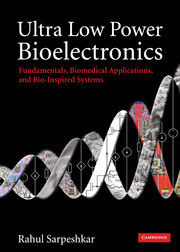Book contents
- Frontmatter
- Contents
- Acknowledgements
- Section I Foundations
- 1 The big picture
- 2 Feedback systems: fundamentals, benefits, and root-locus analysis
- 3 MOS device physics: general treatment
- 4 MOS device physics: practical treatment
- 5 MOS device physics: small-signal operation
- 6 Deep submicron effects in MOS transistors
- 7 Noise in devices
- 8 Noise in electrical and non-electrical circuits
- 9 Feedback systems
- 10 Return-ratio analysis
- Section II Low-power analog and biomedical circuits
- Section III Low-power RF and energy-harvesting circuits for biomedical systems
- Section IV Biomedical electronic systems
- Section V Principles for ultra-low-power analog and digital design
- Section VI Bio-inspired systems
- Section VII Energy sources
- Bibliography
- Index
- Epilogue
- References
10 - Return-ratio analysis
from Section I - Foundations
Published online by Cambridge University Press: 02 December 2010
- Frontmatter
- Contents
- Acknowledgements
- Section I Foundations
- 1 The big picture
- 2 Feedback systems: fundamentals, benefits, and root-locus analysis
- 3 MOS device physics: general treatment
- 4 MOS device physics: practical treatment
- 5 MOS device physics: small-signal operation
- 6 Deep submicron effects in MOS transistors
- 7 Noise in devices
- 8 Noise in electrical and non-electrical circuits
- 9 Feedback systems
- 10 Return-ratio analysis
- Section II Low-power analog and biomedical circuits
- Section III Low-power RF and energy-harvesting circuits for biomedical systems
- Section IV Biomedical electronic systems
- Section V Principles for ultra-low-power analog and digital design
- Section VI Bio-inspired systems
- Section VII Energy sources
- Bibliography
- Index
- Epilogue
- References
Summary
You don't understand anything until you learn it more than one way.
Marvin MinskyIn this chapter, we shall discuss a feedback technique for analyzing linear circuits, invented by Hendrik W. Bode in his landmark book, Network Analysis and Feedback Amplifier Design published in 1945. The technique, known as return-ratio analysis, allows one to compute the return ratio of an active dependent generator or passive impedance in a linear circuit as a function of its dependent gain or of its passive impedance, respectively. The return ratio is a quantity analogous to the loop transmission in a feedback loop: just as we can use the loop transmission in a feedback loop to analyze how the dynamics of the loop changes as we vary its dc gain, we can use the return ratio of an element to analyze how transfer functions in the circuit change as we vary the dependent gain or passive impedance of the element. The return ratio also gives us a measure of the robustness of the circuit to changes in the gain or impedance of the element in the same manner that the loop transmission gives us a measure of the robustness of a feedback loop to changes in its feedforward gain. The return ratio explicitly realizes that circuits are composed of bidirectional elements and loading such that the creation of unidirectional block diagrams with feedforward gain a(s) and feedback gain f(s) to analyze them is not unique and sometimes cumbersome.
- Type
- Chapter
- Information
- Ultra Low Power BioelectronicsFundamentals, Biomedical Applications, and Bio-Inspired Systems, pp. 240 - 272Publisher: Cambridge University PressPrint publication year: 2010



